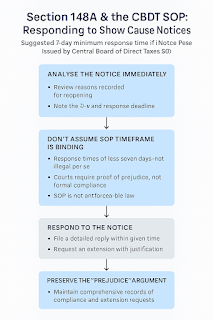By CA Surekha Ahuja
Legal Validity, Prejudice Test, and Practical Action in Light of Calcutta High Court Ruling
The Finance Act, 2021 introduced Section 148A into the Income-tax Act, 1961, marking a significant procedural reform in reassessment law. It requires the Assessing Officer (AO) to issue a prior show cause notice under Section 148A(b) and grant the assessee a chance to be heard before issuing a notice under Section 148.
To support implementation, the CBDT issued a Standard Operating Procedure (SOP) suggesting that a minimum of seven days be allowed to the assessee to respond to the notice. However, in a recent ruling, the Calcutta High Court in Mukul Mahanta v. Union of India [[2025] 176 taxmann.com 251] clarified that SOPs do not have the force of law, and deviation from them does not automatically invalidate the proceedings.
This article explains the legal position, demystifies the impact of the judgment, and sets out a clear and practical response strategy for taxpayers facing such notices.
Key Judicial Clarifications
In Mukul Mahanta, the assessee challenged the reassessment on the ground that only four days were granted to respond to the notice under Section 148A(b), whereas the SOP mandated a minimum of seven days. The High Court rejected the challenge, laying down the following legal principles:
-
CBDT’s SOP is not binding law – It is an internal administrative guideline and not enforceable in courts.
-
Shorter time to reply does not vitiate reassessment proceedings – Unless the assessee proves actual prejudice.
-
Violation of natural justice requires proof of prejudice – A technical breach without consequence is not enough.
-
Reassessment orders are appealable – A writ petition is not the appropriate remedy when statutory appellate forums are available.
These findings were supported by:
-
P.L. Goenka HUF v. PCIT [[2025] 174 taxmann.com 588]
-
State of U.P. v. Sudhir Kumar Singh (2021) 19 SCC 706, where the Supreme Court held that natural justice is not a rigid doctrine, and actual prejudice must be shown to invalidate a proceeding.
Legal Framework Under Section 148A
Section 148A lays out the steps to be followed before issuing a reassessment notice:
-
Section 148A(a) – Enquiry with prior approval, if required
-
Section 148A(b) – Issue of a show cause notice with opportunity to be heard
-
Section 148A(c) – Consideration of reply
-
Section 148A(d) – Decision by a speaking order whether to issue notice under Section 148
The CBDT’s SOP recommends that a minimum of 7 days be given to respond to the notice under 148A(b). However, that is only a guiding norm, not a statutory right.
What Should the Assessee Do Upon Receiving a Section 148A(b) Notice?
1. Examine the Notice Immediately
Check:
-
The date and time of issuance
-
The deadline for reply
-
The information or allegations indicating income escaping assessment
Even if the notice grants less than seven days to reply, that is not illegal per se.
2. Do Not Assume the SOP Time Limit is Enforceable
Many taxpayers mistakenly treat CBDT SOPs as binding. However, as clarified in Mukul Mahanta, no enforceable right arises from the SOP. A deviation from the SOP alone is not sufficient to invalidate proceedings.
3. File a Reply Within the Timeframe or Seek an Extension
-
Wherever possible, respond substantively within the time provided.
-
If more time is required, seek a written extension citing valid reasons such as:
-
Requirement of voluminous data or third-party inputs
-
Temporary absence of counsel or authorised signatory
-
-
Maintain documentary proof of any extension request, acknowledgement, or reply filed.
4. Preserve the Argument of Prejudice
If reassessment is later carried out, and you believe the short time materially impacted your ability to respond:
-
You may raise this point in appellate proceedings.
-
However, you must establish actual prejudice—for example, that critical facts or documents could not be presented due to insufficient time.
Courts require more than just a claim of procedural unfairness. They need to see demonstrable harm or denial of fair hearing.
5. Use the Appellate Remedy — Not the Writ Route
If the AO passes a reassessment order under Section 147:
-
File an appeal before the Commissioner (Appeals) under Section 246A within 30 days.
-
Raise both substantive tax issues and procedural violations, backed by evidence.
-
Courts will expect you to exhaust this remedy unless exceptional circumstances exist.
Common Misconceptions and the Legal Reality
| Misconception | Legal Reality |
|---|---|
| SOP violation automatically invalidates reassessment | ❌ No. It must result in real prejudice to be actionable. |
| Less than 7 days to reply violates natural justice | ❌ Not unless the assessee was unable to defend due to the limited time. |
| SOP is enforceable like a rule or circular | ❌ It is only an internal administrative tool. |
| Writ petition is a substitute for appeal | ❌ Writs are not maintainable where alternative appellate remedies exist. |
Conclusion: Substance Over Form
Taxpayers should not overly rely on CBDT SOPs or procedural technicalities when responding to notices under Section 148A(b). Courts are now looking for substantive fairness, not just procedural perfection.
If the time to respond is short:
-
Act immediately—file a reply or request a reasonable extension.
-
Maintain complete records of all communications.
-
Be prepared to prove prejudice later, if required.
-
If reassessment follows, challenge it through appeal, not writ.
Ultimately, a strategic, documented, and timely response remains the best protection against an adverse reassessment outcome.
"The law favours those who act. Not those who wait for perfect process."

